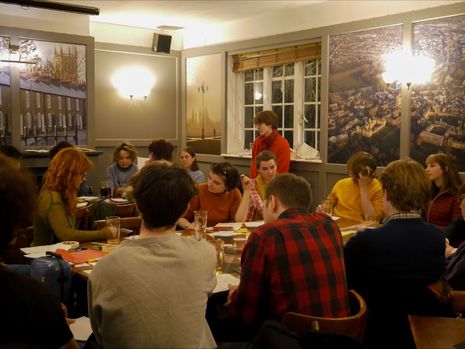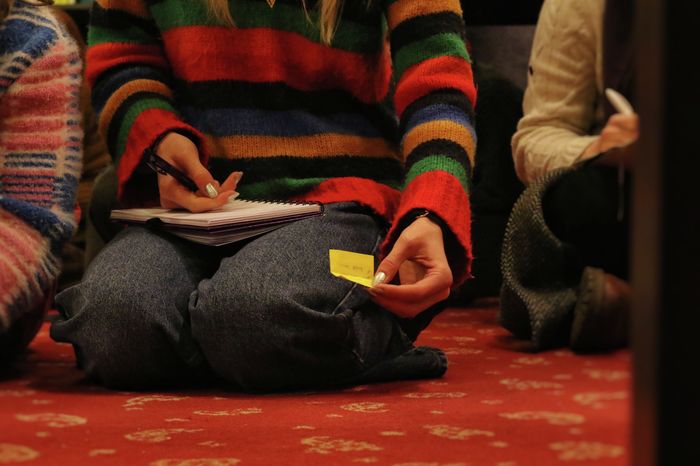The Mays: In conversation with the editors
Loveday Cookson speaks to Leo Kang and Famke Veenstra-Ashmore about the publication of this year’s Mays anthology

The Mays, an annual anthology cataloguing the poetry, prose, and art of the current Oxbridge population, has found a new iteration this year, led by editors-in-chief Leo Kang and Famke Veenstra-Ashmore. The publication is unique, transcending the remits of a typical student zine or publication. Leo describes it as “unusually professional”; it gathers a team of editors to “broadcast a great range of new student work” while offering the students themselves a taste of the publishing industry. Each editor approaches the project with their own vision, utilising every ounce of creative freedom to realise the book they held in their head as they typed out their application. For Leo and Famke, this is one of variety, embracing every aspect of creativity on offer.
Famke explains how “it was amazing to see how many people just wanted to write, working within different types of prose and poetry, which was innovative, playing with forms. Fake translations, parodies, lots of funny stuff that showcased what people are writing a lot of, writing now and writing quite urgently too.” This sense of “now” radiates from our discussion: wanting the anthology to capture the “now”, these thoughts, these students. Their Mays is not about fitting a predetermined template or guideline of what makes a great anthology – it is about the work, wonderful work from a cross-section of the universities’ populations. It is about finding the greatness of their own anthology through the offerings of others. Leo explains how “student creativity is more than just what we see in zines, or what we have seen or come to believe student poetry is like”. We kept returning to the word “eclectic”, encapsulating the vision they both held: “It is for students, it is student writing, and we want to showcase up-and-coming talent and the wackier writing that students are doing that may not get published elsewhere”.
“Student creativity is more than just what we see in zines, or what we have seen or come to believe student poetry is like”
To foster this mix of voices they held a poetry event: scribbling the contents of our notes apps on post-it notes, we then made them into haikus, crafted sonnets from shopping lists, and found poetry within newspaper clippings arduously procured by a dedicated editing team. Held in the top room of pub The Maypole, the evening was one of warmth, with nothing but support. Even my own questionable haikus were met with encouragement and appreciation. Leo explains how he “brought three NatSci boys who have never written anything creative in their lives”, and this summarises the beauty of their anthology: you can be a NatSci or an Engling, write about wood pigeons or Chopin, and it somehow fits seamlessly into their creation, as you “can produce more interesting and unexpected connections when you put pieces together that don’t fit a certain model”.
Editing the anthology is more than perusing poems, cup of coffee in hand; it is admin and cold emails, collating an entire book while procuring the highly anticipated guest editors. “You have to just try your best and hope that some people reply – people are very busy”, says Famke; judging from the guests’ calibre, they have done more than their best, with Denise Riley and Lemn Sissay putting their names to the anthology this year. Leo adds that they wanted the guest editors to feel “relevant to student writing and writing in general”, with both having an Oxbridge connection as well as having poetry that continually speaks to a generation.
“Emotion … stands out, it strikes a cord, and lots of student writing is emotional, it’s expression”
The incredible creations of Emily Lawson-Todd intersperse The Mays, from doodles of the editorial team to the cover – a woman traversing the front with an arresting gaze and her Klimt-esque coat. Emily’s work has an “emotion in it that stands out, it strikes a cord, and lots of student writing is emotional, it’s expression; covers that are just plain or a pattern don’t necessarily capture this”, Leo explains. Her work is as vibrant as the community it represents, as “even the small Instagram posts we have, have the coolest cartoon people illustrated by Emily. Hopefully it fits the vibes that it is a creative community with faces” – the illustrations humanise what can be a mythical process and product. A key aim for the team was the promotion of a Mays community, built upon past members, contributors, and readers, all playing a role in the anthology’s conception. “The Mays is a living and vibrant community – still publishing at the forefront of student creativity – an opportunity to see student work at the beginning of their path. If you want to see what the new generation, or a snapshot of what a new generation of creative work may look like, it is here.”
The big question: why should you buy The Mays? From what I know about this year’s edition, it swells with the “eclectic” variety that tripos doesn’t always offer, full of innovation, “seeing things for what they are with no aesthetic agenda.” While we may not all go on to become Zadie Smith, who was first published in The Mays, what the anthology does – because of what Famke and Leo have created – is give readers “a sense of what people are thinking about right now”, what feels “urgent” to a student body at this moment in time. If you want to see what the future of writing looks like – you’ll find it here.
 Comment / Plastic pubs: the problem with Cambridge alehouses 5 January 2026
Comment / Plastic pubs: the problem with Cambridge alehouses 5 January 2026 News / SU stops offering student discounts8 January 2026
News / SU stops offering student discounts8 January 2026 News / Uni-linked firms rank among Cambridgeshire’s largest7 January 2026
News / Uni-linked firms rank among Cambridgeshire’s largest7 January 2026 News / New movement ‘Cambridge is Chopped’ launched to fight against hate crime7 January 2026
News / New movement ‘Cambridge is Chopped’ launched to fight against hate crime7 January 2026 News / Cambridge businesses concerned infrastructure delays will hurt growth5 January 2026
News / Cambridge businesses concerned infrastructure delays will hurt growth5 January 2026









